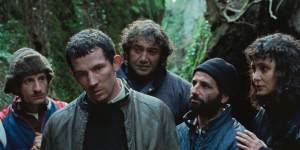In Greek myth,the chimera was a fire-breathing creature with the head of a lion and the body of a goat:a monstrous hybrid,something that ought not to exist. But in English and other languages,“chimera” is also a general term for that which doesn’t exist,materially speaking:a mirage,a trick of the light.
As this suggests,there are a lot of allegorical things going on inLa Chimera – the most striking film yet from the Italian director,following her similarly dreamy,yet ambitiousHappy as Lazzaro in 2018. Literally speaking,we’re in a rural backwater somewhere like Tuscany,where an abashed dandy named Arthur (Josh O’Connor),otherwise known as “the Englishman,” arrives after a stint in prison.

La Chimera is the most striking film yet from the Italian director Alice Rohrwacher.PalaceFilms
Arthur isn’t much of a talker,but he has a gift – “the gift of finding lost things,” as one character puts it. Specifically,he goes dowsing with a twig like a water diviner,except his sixth sense isn’t for underground streams,but for artefacts from centuries past. Like Jesus with his miracles,he attracts a band of local disciples,and together they go about raiding tombs in search of Etruscan antiquities,to be sold at a fraction of the price they would go for if acquired by legitimate means.
Counterpointing the seediness of this profession is Arthur’s devotion to his lost love Beniamina (Yile Yara Vianello),glimpsed only in dreams and flashbacks. Her fate isn’t spelt out,but his grief in the present binds him to her mother Flora (Isabella Rossellini),a grand old lady who gives music lessons from her crumbling but imposing hillside villa:a living symbol,a treasure in her own right.

Isabella Rossellini is a treasure in her own right in La Chimera.PalaceFilms
In general,the movie is in no hurry to explain itself (the period is the 1980s,but it took me a while to deduce this,despite the lack of computers and mobile phones).
The magic realist approach means that anything can happen,not just within the story but stylistically as well:the aspect ratio can shift,synth chords can invade the soundtrack,a minor character can speak to the camera or the camera itself can turn upside down.
Figuratively,it’s Rohrwacher too who is digging up the past,the cinematic past included. Some of her cavorting,brawling minor characters are straight out of the films of – who also had a similar way of setting different eras side by side,as in the famous opening shot ofLa Dolce Vita where a statue of Christ is flown by helicopter over the ruins of an aqueduct.
Ultimately,the problem dramatised here is the same one faced by any modern artist:how do you retain a meaningful link to your predecessors while shaping something new? Rohrwacher’s answer is the film itself,which,despite everything,retains a flowing quality,as if there were a hidden logic governing all its unexpected turns. Like her characters,she’s in pursuit of something beyond price,which might fade or crumble if snatched at too directly.
La Chimera is in cinemas now.
Find out the next TV,streaming series and movies to add to your must-sees..
